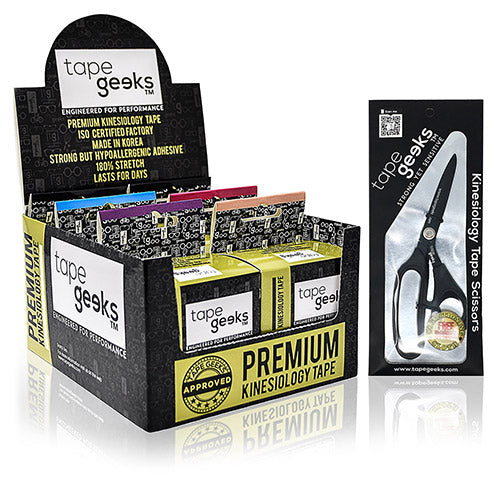
As humans, we take all sorts of things for granted – breathing (until you fracture a rib that is), walking (until you break an ankle), and the natural grip strength of our dominant hand!
Lateral epicondylitis/epicondylalgia (LE), or tennis elbow, as it’s more commonly referred to, can be a surprisingly debilitating injury when one thinks about the number of times in any day that we need to use even a small amount of grip strength to pick something up, hold a cup or laptop or grab a grocery bag… the list becomes very long when counting the uses of a hand in a 12-hour workday.

Shop our kinesiology tape now
Shop Now
In a well-written review article (1)the author calls this type of elbow pain, the “midlife crisis tendon” because of the condition’s dominance in the middle-aged population of both genders.
LE is estimated to affect 1-3% of the population at any time with symptoms lasting between 6 and 24 months! That’s a long time to curtail the use of a dominant hand!
There are a variety of details about the pathophysiology of the tendon, the cells, and the changes in vascularization but suffice it to say that by middle age, we’ve gripped A LOT and often too hard and for too long and in the case of athletes such as tennis players, with vibration into the arm!
Accordingly, there are changes to the tendon itself such as cell type, collagen formation, and local neurochemicals. Interestingly, however, there are usually few, if any inflammatory cells beyond the initial stages, which suggest that this elbow pain isn’t so much of an “itis” (inflammation) as it is an “algia” (pain).
So you have sharp pain at the outer elbow that may even radiate into your hand, now what?
Unless you have experienced LE before and/or are a medical professional, you really should seek the advice of a therapist for both an assessment and plan of action.
Here are all of the possible treatment choices (in no particular order) and their advantages:
- Over-the-Counter NSAIDs. Give temporary relief but do not improve the long-term outcome
- Cortisone Injection. Provide short-term pain relief but with a very high recurrence rate and therefore no long-term benefit
- Exercises, Specifically an eccentric exercise program done daily at 3 sets of 10-15 repetitions gave good results (if the patients complied with the program)
- Ultrasound. Commonly used but little evidence to suggest it improves the outcome
- Shock-Wave Therapy. Shows little if any improvement
- Manual Therapy. (2) such as some manual/mobilization techniques do improve LE in both the short and long term when compared to a placebo
- Surgery. As a last resort and so far evidence in support of going this route is lacking… a lot of extra pain for no particular gain.
- Kinesiology Taping. Has some support to lessen discomfort and improve grip strength so let’s look more closely at this non-invasive option.

Shop our bundles now
Shop Now
A 2016 study (3) of 32 patients used kinesiology tape, twice a week for 2 weeks then asked the participants to rate their pain at rest, during daily activity, at night, and upon palpation of the elbow as well as grip strength is measured by a dynamometer (a gauge of pressure).
When compared to the ratings prior to using the kinesiology tape, the 2-week and 6-week participant ratings showed statistically significant improvements in all areas.
However, just to provide complete contrast (and confusion), a 2017 study (4) using a different blinding technique demonstrated that the kinesiology tape did not provide significant improvements in pain and grip strength.
So what to do?
Experiment with the safest approaches that show some proof of results.
Try the following:
- Kinesiology taping
- Eccentric exercises (a good pdf is available HERE)
- Consult with a therapist who has training in specific manual techniques such as ART® or similar method
Lateral Epicondylalgia is a common and annoyingly persistent condition that a high percentage of the aging population will have to manage. It’s hard to eliminate quickly so the best advice is to pick a treatment plan that is easy and inexpensive. You’re in for a long ride so it may as well be a plan that fits into your lifestyle for at least 6 months.
Are you interested to learn about different types of injuries like runner's knee or biceps tendinitis? Visit our blog!

Shop our collection now
Shop NowSubscribe to the TapeGeeks Newsletter for new videos, discounts and more!Join The Geeks Club
1. Luk J. Lateral epicondylalgia: midlife crisis of a tendon. Hong Kong Med J 2014;20:145–51 | Number 2, April 2014
2. Herd CR, Meserve BB. A systematic review of the effectiveness of manipulative therapy in treating lateral epicondylalgia. J Man Manip Ther 2008;16:225-37.
3. Dilek B. Batmaz. Kinesio taping in patients with lateral epicondylitis. J Back Musculoskelet Rehabil. 2016 Nov 21;29(4):853-858.
4. Au IPH. Fan PCP. Effects of Kinesio tape in individuals with lateral epicondylitis: A deceptive crossover trial. Physiother Theory Pract. 2017 Dec;33(12):914-919









